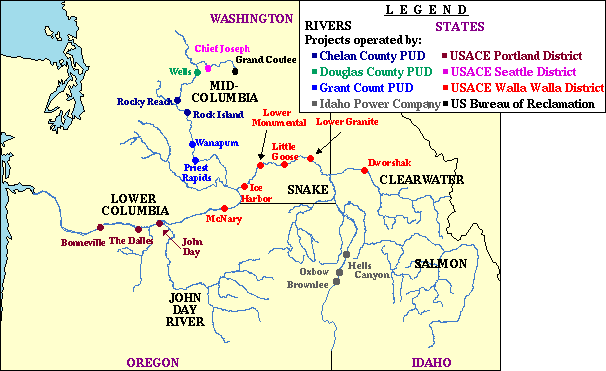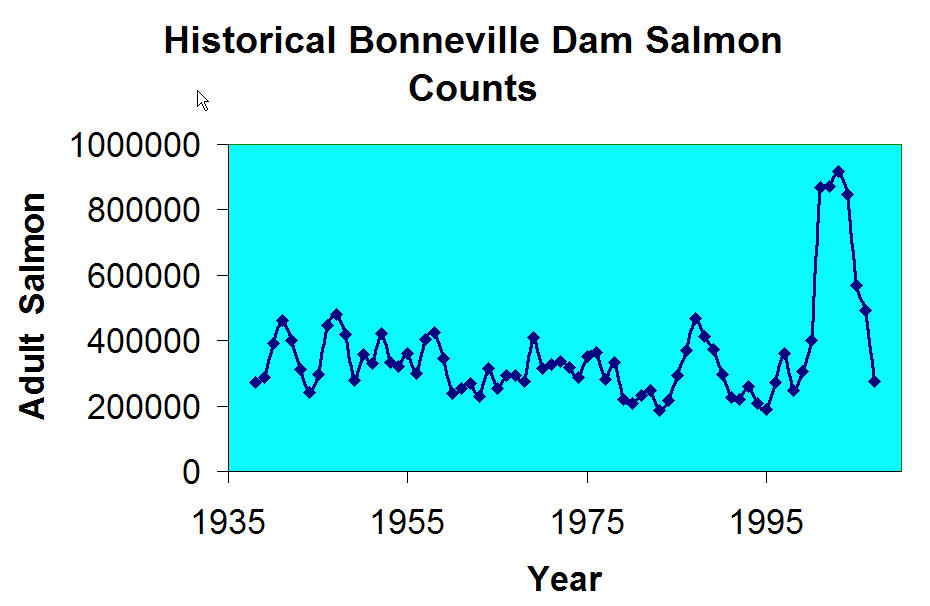One of the most well known environmental battles involves the struggle between the need
for hydroelectric dams on the Columbia and Lower Snake rivers vs the need for healthy
spawning habitat for salmon.
This battle has had many dimensions but, so far, no real solutions have emerged. The
reason for this is emblematic of many environmental problems - it depends largely
on how the problem is framed and what data is used to define the problem.
Let's first start at the issue of dams causing the decline of salmon.
The principle hypothesis here is whether or not dams have cause
a "catastrophic" loss of population.
We can use salmon count data as a means
of establishing a baseline and to see if there is a decline in that
baseline over time. We can then convolve that data with
the following simple model:
X ----------|-------------|--------|------|--------|----|---|--|-> X'
1 2 3 4 5 6 7 8
Suppose we have a system where X salmon enter and have to pass 8
dams to reach X'.
The issues are:
- How many fish are eliminated by the first dam
- how many are eliminated by success dams?
- does fish survival probability depend on dam size? distance
from the mouth of the columbia river (assumes salmon get tired
and find fish ladders more difficult to negotiate); salmon learning
curve (assumes that salmon learn to look for fish ladders along
the way thus reducing the mortality rate).
Under the model where all dams are equal then we should see
something like this in the data.
X1 < X2 < X3 < X4 < X5 < ...
While there may be other complicating factors such as salmon spawning tributaries
between dams, it is reasonable to assume that the upstream migration pattern
takes a hit each time that pattern encounters a dam. At least that is what
we believe the outcome should be.
These hypothesis can be tested to some extent by the actual salmon
count data which exists at each dam (
Link to actual count data ) that exist
within this overall system


The above shows the wave form of the historical salmon counts at Bonneville dam from 1935 to 2005:
all counts at the other dams show similar wave forms. There a number of important
and complicating features of this diagram that bear directly on the environmental
issue of salmon decline.
- Clearly the salmon counts are cyclical in nature (
see this visualization ), alternating between peaks
and troughs on various timescales. This is most likely related to similar
variations
in PNW climate that determines river temperature and stream flow.
- Salmon started to become an environmental icon in the mid 1990's which was clearly one
of the cyclical times of low salmon. Salmon counts at this time were about a factor of 2
below what was seen in the mid 1980's and this lead to cries of salmon decline. Within this
context, its important to note that the last dam built in the system was completed in 1972.
Bonneville dam was constructed in 1935 and by the late 1950's McNary and the Dalles dam was
constructed - yet its hard to see evidence of dam construction in this historical wave form.
- There seems to be some kind of "natural" minimum floor of about 200,000 salmon. None of
the low periods dip beneath that.
- The period 2001--2004 represents and enormous increase in the observed Salmon. This was
not caused by an increase in salmon detection efficiency but instead this represents truly
record salmon runs on the Columbia river, which is likely a manifestation of the "success" of
the fish hatchery industry.
- Since 2004 there has been a precipitous drop in the salmon counts, much more strongly than
the 1985 to 1995 drop. This is most likely a reaction to adverse climate conditions in the region. Your last homework assignment
will ask you to extend the above wave form to more recent years.
Thus the salmon decline issue is complex and there are many factors at work that can affect
various aspects of this environmental problem. The following table tries to summarize this
complexity:
Salmon Decline Matrix
| Problem | Dams | Logging | Changing
Climate
| Agriculture | Pop. Growth | Over Fishing | Other |
| Salmon Migration Barriers | Big Time | no | no | no | no | no | no |
| Barriers to Reaching Spawing Grounds | Yes | no | Yes | no | no | Yes! | no |
| Reduced Number of Young Salmon reaching sea | yes | yes | no | no | no | no | bird
predation |
| Pesticide Exposure | no | Yes | no | Yes | no | no | no |
| Industrial Pollutants Exposure | no | no | no | no | Yes | no | no |
| Loss of Streamside Vegetation and Functions | no | Yes | no | Yes | Yes | no | no |
| Increased Sediment Load | no | Yes | Yes | Yes | Yes | no | no |
| Natural Habitat Destruction | yes | yes | no | yes | yes | no | no |
| Reduced Fresh Water Flow in Rivers and Streams | yes | no | no | yes | yes | no | no |
| Abnormal water temperatures | yes | no | yes | yes | no | no | no |
| Reduced upwelling and nutrient/food supply | no | no | yes | no | no | no | competition with hatchery fish |
| Estuary Degradation | no | Yes | no | no | Yes | no | no |
| Loss of cool deep pools in streams | no | Yes | no | no | no | no | no |
If your seriously interested in this environmental issue then
you read the
the extensive annual report as well
as this resource
and this one
Finally, a few words about escaped salmon from fish farms:
The reason the issue of escaped salmon deserves our attention is that
there are legitimate environmental concerns that result
from a farmed fish escaping. In British Columbia, both Atlantic and
Pacific salmon are being raised in farms and each of these
two species poses unique risks once they do escape. For Atlantic, there's
hybridization, which is basically Atlantic and salmon
crossbreeding -- Atlantic and Pacific salmon crossbreeding. The other is
predation and competition. This involves the Atlantic
feeding on wild Pacific salmon, as well as other food supplies, and then
the taking of space and the wild habitat in general.
Another major concern is spawning site disruption by Atlantic salmon. The
stems from the fact that Atlantic salmon spawn later
than Pacific salmon so there's a risk that they enter the same streams
that the Pacifics have already spawned in and then they
disrupt the eggs that the Pacific salmon have already placed. And also,
Atlantic salmon mature faster than Pacific salmon, and so
they have a competitive, or they give to the Pacific salmon a competitive
disadvantage due to their smaller size. Another concern
is colonisation of Atlantics in BC, which would have severe impacts on the
wild stocks -- mainly because they would be using
the same streams that wild Pacific stocks presently use to spawn. And
finally, there is the issue of the spreading of diseases from
the farmed salmon to the wild Pacific salmon.
| 
